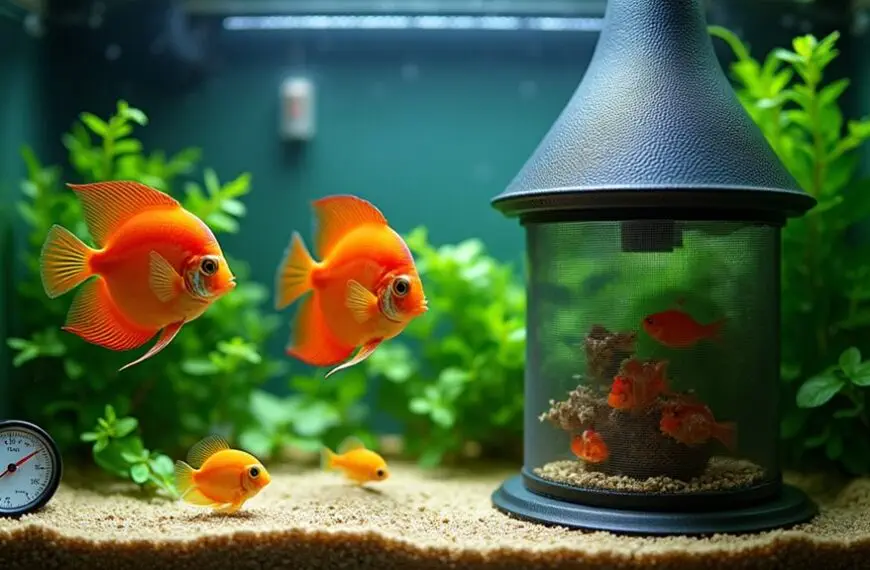Using different breeding techniques for freshwater fish is like cooking with diverse recipes—each one serves a unique purpose! It's all about matching the technique to the fish species and their specific needs. For example, livebearers like guppies have different requirements than mouth-brooders. Plus, maintaining optimal water conditions and feeding routines boosts breeding success and keeps your fish happy. Different methods also help protect fry from predators and ensure better survival rates. So, whether you're a newbie or a pro, mixing things up can lead to a vibrant aquarium. Stick around, and you'll discover even more tips for a thriving aquatic setup!
Contents
Importance of Species Selection
When it comes to freshwater fish breeding, your choice of species can make or break your success. Selecting the right species is crucial because different types require unique conditions.
For beginners, livebearers like guppies and mollies are a breeze. They're forgiving and fun to watch! Additionally, fish such as goldfish offer a resilient option for newcomers, while egg-layers, such as tetras and cichlids, demand more specific water conditions and breeding techniques.
Compatibility is key, too. Pairing compatible fish helps avoid aggression, ensuring a peaceful community aquarium. Imagine trying to throw a party with the wrong guests—yikes!
Assess your personal expertise before diving in. If you're a newbie, stick with easier species like platies and swordtails. Advanced aquarists can tackle more challenging or even endangered species.
Understanding the natural behaviors of spawning fish is also essential. Some might need specific environmental triggers, like temperature changes, to get in the mood for love. So, do your research! Knowing what your chosen species need will enhance your chances of producing healthy offspring and contribute to sustainable aquarium practices.
After all, a well-informed aquarist is a successful one!
Overview of Breeding Techniques
Understanding the various breeding techniques for freshwater fish is vital for any aquarist looking to successfully raise healthy offspring. Each method has its unique charm and challenges, so let's dive in!
First up, we've got live-bearing species, like guppies and mollies, which give birth to tiny, fully formed fry. They love having hiding spots to keep their little ones safe from curious tank mates.
Then there are the egg scatterers, such as tetras, who spread their non-adhesive eggs across the breeding tank. These little eggs get little to no parental care, so be prepared!
Next, we've substrate spawning species, including some cichlids, who lay their eggs on a solid surface. Their fry get a bit more protection thanks to the caring parents.
Finally, let's not forget mouth-brooding fish, like mbuna cichlids. These devoted parents incubate their eggs in their mouths—talk about a cozy nursery!
Each of these aquatic species brings something special to your tank, so choose the right technique that fits your goals and enjoy the incredible journey of fish breeding!
Maintaining Optimal Water Conditions

To ensure successful breeding of freshwater fish, maintaining optimal water conditions is essential.
You'll want to keep an eye on your water parameters, starting with a stable water temperature that matches the preferences of your fish species. For instance, tropical fish love it warm, typically between 75°F and 80°F.
Regular testing is vital for early detection of water quality issues, as essential test parameters like pH and ammonia levels play a crucial role in fish health. Don't forget about pH levels! Keeping them within the ideal range for your fish is crucial; discus fish, for example, thrive in softer water around pH 6.0-6.5.
Regular water quality tests using reliable kits will help you track ammonia, nitrite, and nitrate levels. Aim for zero ammonia and nitrite to ensure a healthy breeding environment.
Also, make water changes a weekly ritual—25-50% is a good rule of thumb. This helps maintain a clean, well-oxygenated home for your fish.
Speaking of oxygen levels, ensure your tank has proper aeration and water movement. After all, healthy fish are happy fish, and they need oxygen-rich water for those successful breeding outcomes.
Conditioning Fish for Breeding
Conditioning fish for breeding is a critical step in ensuring successful spawning. You want to give your fish a varied, high-quality diet that boosts their health and reproductive readiness. Think of it as preparing them for a big event! A diet rich in protein, along with some tasty live foods and premium flakes, can significantly improve fertility rates. They'll be energized and ready to create healthy offspring.
Maintaining optimal water parameters, such as stable pH and temperature, is crucial for enhancing their breeding behaviors and overall health, as proper water parameters matter.
Ideally, you should start conditioning several weeks before breeding. This gives your fish time to build up energy reserves and improve their breeding behaviors. Remember, each fish species has specific needs when it comes to temperature, pH, and water quality. Meeting these conditions can mimic their natural habitats and trigger those important breeding instincts.
Keeping a stable and clean environment is also essential. Regular water changes help prevent stress and diseases that could derail your breeding plans.
Rearing Fry and Egg Care

When it comes to rearing fry and caring for eggs, you'll want to create the perfect environment for those little swimmers to thrive.
Think of it like setting up a cozy nursery where fry can grow strong and healthy, and you'll need to keep their meals as varied as a buffet to keep them happy.
Let's explore the stages of fry development, the best egg care techniques, and some tasty feeding strategies that'll make your aquatic babies flourish!
Fry Development Stages
As fry emerge from their eggs, they go through distinct development stages that require careful attention to their needs. When fry hatch, they initially rely on their yolk sacs for nourishment.
But just a few days in, they'll be actively seeking food! To support their growth, provide a nutritious diet that starts with infusoria and egg yolk, then gradually introduce live foods like Daphnia and whiteworms.
You'll also want to group fry by size to prevent any accidental snacking—no one wants a cannibalistic aquarium! Daily water changes of 25-50% are crucial to maintaining optimal water conditions, keeping the little ones healthy and thriving. Remember, clean water equals happy fry!
Adding some plants or rocks to their environment can give your fry the cover they need, enhancing their survival rate during these delicate stages.
After all, a well-cared-for fry has the potential to grow into a beautiful adult fish. With your dedication and attention, you'll help them flourish into healthy fish that bring joy to everyone.
Egg Care Techniques
To ensure successful egg care and promote healthy fry development, maintaining optimal water conditions is crucial. Regular water changes and proper pH levels help prevent those pesky fungal infections that can wreak havoc on your eggs or fry.
For egg-burriers, using peat moss as a substrate is a great egg care technique, allowing for safe storage until hatching. If you're working with mouth-brooders, isolating them during breeding can minimize aggression towards their precious eggs.
Once those tiny fry hatch, you'll want to meet their nutritional needs right away. Start them off with infusoria or egg yolk, and as they grow, transition to high-quality commercial options like Daphnia and brine shrimp.
In your dedicated rearing tank, regularly sorting fry by size is essential. This prevents cannibalism, which, let's face it, isn't a fun surprise!
Plus, using spawning mops or specific nesting materials can provide secure environments, increasing the chances of fry survival. With these tips, you're well on your way to creating a thriving aquatic community. Happy breeding!
Feeding Strategies for Fry
Feeding your newly hatched fry is critical for their growth and development, and it starts the moment they absorb their yolk sacs.
Once they're ready, you'll need to provide them with nutritious foods to support rapid growth.
Here's a simple guide to help you raise fry successfully:
- Start with Infusoria: This tiny food is perfect for newly hatched fry. It's like a buffet for them!
- Introduce Brine Shrimp: As your fry grow, they can handle brine shrimp nauplii. It's a tasty treat that promotes strong development.
- Feed Multiple Times a Day: Offer small amounts several times daily. This helps prevent overfeeding and keeps water quality in check.
- Use a Sponge Filter: Install one in the fry tank to maintain water quality without harming your delicate little ones.
Don't forget the importance of observation of fry.
Healthy fry are active and eager to feed. If you notice they're not as lively, it may be time to tweak their diet.
With a little patience and care, you'll witness the joy of fish breeding as your fry thrive!
Tips for Breeding Success
Successful breeding of freshwater fish hinges on several key techniques that can significantly enhance your outcomes.
First, focus on creating the perfect environment for your breeding pairs. Use separate breeding tanks to minimize stress and keep those lovebirds happy.
Now, let's talk about stable water parameters—make sure you tailor them to the specific fish species you're working with. This means keeping an eye on temperature, pH, and hardness, so your fish feel right at home.
Next up, a high-quality diet is essential! Feed your breeding pairs a varied selection of nutritious foods to boost their reproductive success and the vitality of their fry.
While they're getting cozy, you should be monitoring fish behavior closely. This will help you identify compatible pairs and ensure smooth spawning without territorial disputes.
Don't forget about regular water changes! Keeping the water fresh is crucial for both the adults and the rearing fry.
Frequently Asked Questions
What Technique Is Used for Fish Breeding?
When you breed fish, techniques like natural spawning, hormone induction, and artificial fertilization come into play. You can also explore cage breeding, tank cultivation, and aquaponics integration for effective broodstock management and environmental manipulation during breeding cycles.
What Are the Breeding Strategies of Fish?
Imagine a cichlid pair nurturing their eggs on a flat rock. You'll notice their spawning behaviors and parental care significantly influence fry development, showcasing how habitat and environmental factors shape reproductive cycles and genetic diversity in aquaculture practices.
What Are the Advantages of Selective Breeding in Fish?
Selective breeding offers you improved traits like disease resistance and growth rates, enhances reproductive success, and fosters environmental adaptability. It boosts genetic diversity while meeting market demand, supporting sustainable practices in your breeding programs for healthier fish.
How Many Method Are Used for the Breeding of Fishes?
You can use five main methods for breeding fish: natural spawning, artificial propagation, hormonal induction, and broodstock management. Each requires proper tank conditioning, water quality, spawning substrates, and attention to species compatibility for successful larval rearing.
Final Thoughts
Breeding freshwater fish can be pretty rewarding, especially when you see those little fry swimming around. Did you know that some fish can produce over 1,000 eggs in a single spawning? That's a lot of tiny fish to care for! By using the right techniques and keeping everything in tip-top shape, you'll boost your chances of success. So, whether you're a newbie or a pro, remember to enjoy the journey and maybe even crack a smile along the way!












